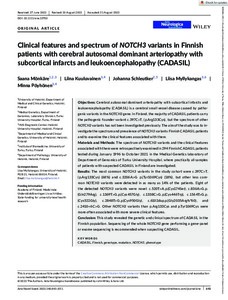Clinical features and spectrum of NOTCH3 variants in Finnish patients with cerebral autosomal dominant arteriopathy with subcortical infarcts and leukoencephalopathy (CADASIL)
Mönkäre Saana; Kuuluvainen Liina; Schleutker Johanna; Myllykangas Liisa; Pöyhönen Minna
https://urn.fi/URN:NBN:fi-fe2022110164040
Tiivistelmä
Objectives: Cerebral autosomal dominant arteriopathy with subcortical infarcts and leukoencephalopathy (CADASIL) is a cerebral small vessel disease caused by pathogenic variants in the NOTCH3 gene. In Finland, the majority of CADASIL patients carry the pathogenic founder variant c.397C>T, (p.Arg133Cys), but the spectrum of other NOTCH3 variants has not been investigated previously. The aim of the study was to investigate the spectrum and prevalence of NOTCH3 variants Finnish CADASIL patients and to examine the clinical features associated with them.
Materials and methods: The spectrum of NOTCH3 variants and the clinical features associated with them were retrospectively examined in 294 Finnish CADASIL patients tested during January 1996 to October 2021 in the Medical Genetics laboratory of Department of Genomics of Turku University Hospital, where practically all samples of patients with suspected CADASIL in Finland are investigated.
Results: The most common NOTCH3 variants in the study cohort were c.397C>T, (p.Arg133Cys) (68%) and c.3206A>G p.(Tyr1069Cys) (18%), but other less common NOTCH3 variants were detected in as many as 14% of the patients. Eight of the detected NOTCH3 variants were novel: c.520T>A,p.(Cys174Ser), c.836A>G,p.(Gln279Arg), c.1369T>G,p.(Cys457Gly), c.1338C>G,p.(Cys446Trp), c.1564T>G,p.(Cys522Gly), c.2848T>G,p.(Cys950Gly), c.6102dup,p.(Gly2035Argfs*60), and c.2410+6C>G. Other NOTCH3 variants than p.Arg133Cys and p.Tyr1069Cys were more often associated with more severe clinical features.
Conclusion: This study revealed the genetic and clinical spectrum of CADASIL in the Finnish population. Sequencing of the whole NOTCH3 gene performing a gene-panel or exome sequencing is recommended when suspecting CADASIL.
Kokoelmat
- Rinnakkaistallenteet [27093]
